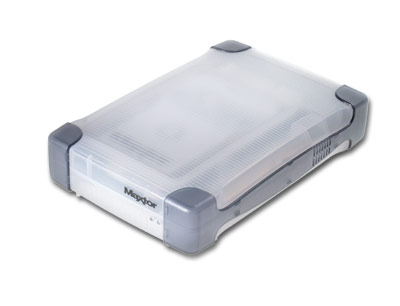The Drive
At
the heart of the drive is Maxtor's Diamond Max 80 ATA100 drive coupled with a
Symbios 13FW500 ATA to 1394 adapter which forms the actual bridge between the
parallel IDE interface and serial 1394 interface. The Diamond Max 80 uses Maxtor's
20GB/platter technology and 4 platters to produce the full 80GB. Spinning at 5400
RPM, the DM80 is currently the largest capacity IDE hard drive on the market,
with only the IBM 75GXP coming close.
With
a seek time of 9ms and 2MB of onboard cache to help keep things moving smoothly,
the DM80 is certainly no slouch in the performance department.
The
drive comes pre-formatted with one large 80GB FAT32 partition and packaged with
a soap-on-a-rope power adapter and 1394 cable for quick installation. Installation
is very straight forward. Plug it in and Windows auto-detects the drive and is
ready to go.
.
This
is actually one of the more attractive external units I have seen in a long time.
The semi transparent housing is very reminiscent of iMac components and is actually
quite stylish.
As
obvious from the design, the case is stackable, saving space in tight quarters.
In addition, at only 41x152x219mm the case is small to start with.
This
drive is really targeted at two markets - general file servers/data backup systems
and home users. Although many consider the 1394 interface to be for digital A/V
use only, it has several features well suited to hard drives.
Firewire
is Hot swappable, meaning that devices can be added and removed without powering
down the computer. This is great for servers where additional hard drive space
must be added and removed without shutting down the system. Home
users will also appreciate not having to power down the system to remove the drive
for storage or transport. Just remember that this is not intended as a mobile
drive. You would not want to carry this drive around in a laptop bag all day -
the IDE hard drive would very likely have data reliability problems. However,
as long as you are careful, the occasional trip is not a problem.
Much
like SCSI, Firewire is a 'chainable' system where devices can be linked together
over a single bus. Maxtor recommends that no more than 16 devices be present on
each chain, but at 80GB per drive, there is a lot of potential for large storage
systems.
One
interesting combo is Windows 2000's RAID abilities combined with a drive like
this. The potential is there for some very, very large volumes. Windows 2000's
RAID 1 and 5 support also brings up some interesting backup scenarios for important
data. RAID 5 would seem to be the most attractive option, providing maximum performance,
fault tolerance, and most user space for the number of physical drives. Granted,
there are several other issues such as performance, but we'll deal with that in
a minute. In reality 4-5 drives per chain is about the maximum for balancing performance
and capacity. However for pure capacity there is really no limit. The sheer expandability
of the 1394 interface makes this drive perfect for file servers and backup systems
where capacity comes first and speed second.